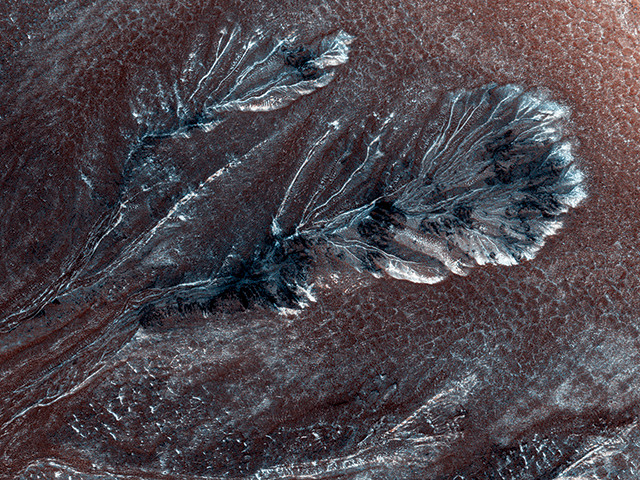
by Timothy Oleson Thursday, April 21, 2016

Seasonal carbon dioxide frost fills gullies amid hilly terrain in a crater on Mars' northern plains. Sublimation of the frost, rather than flowing water, may be responsible for carving the gullies. Credit: NASA/JPL/University of Arizona.
With two rovers patrolling the surface of Mars, five spacecraft orbiting above it, and scientists here on Earth studying the Red Planet from afar, new findings are announced often. Here are a few of the latest updates.
When Mars’ 4,000-kilometer-wide Tharsis region — the largest volcanic complex in the solar system — formed, the hefty mass added to the lithosphere threw off the planet’s balance, causing its axis of rotation and, hence, its poles to shift dramatically. Previous work has attributed the positions and directions of large drainage valleys on Mars, which encircle the planet and date to about 3.5 billion years ago, to this shift, implying that the massive volcanism that formed Tharsis was mostly complete by 3.7 billion years ago. Sylvain Bouley of the University of Paris-Sud in France and colleagues investigated this hypothesis by reconstructing Mars’ landscape and polar positions before the Tharsis “bulge” formed and modeling how the valley networks would have developed without it. The researchers reported in Nature that the valleys would have turned out much the same as they actually did, suggesting that the volcanism did not influence their configuration substantially. The results also suggested that the valley networks and the Tharsis bulge formed at the same time, meaning the volcanism started later and lasted longer into Martian history — as late as 3 billion years ago — than previously thought.
Carbon dioxide, rather than water, may explain the occurrence of seasonally changing gullies on mid- and high-latitude slopes on Mars. The Martian gullies resemble landforms on Earth created by flowing water, and relatively small volumes of liquid water have recently been found to contribute to other surface features observed at equatorial latitudes on Mars. But the gullies would require large quantities of water to carve them, and conditions at the higher latitudes where they’re predominantly seen are even colder and more arid than at the equator, making it unlikely that enough liquid water would be present. In a new study in Nature Geoscience, Cedric Pilorget of Caltech (now at the University of Paris-Sud) and François Forget of the Sorbonne Universities in France modeled how seasonal condensation of carbon dioxide — the major gas in Mars’ atmosphere — on the ground surface might affect the soil underneath. They found that once a layer of carbon dioxide frost solidifies in and over the topsoil, gas pressure at the base of the layer can build up — due to sublimation of carbon dioxide ice back into gas — to the point that the frost layer shatters, loosening pockets of soil and sending them downhill. The model does not account for all characteristics of Martian gullies, but it offers “a good match to many observations of gully activity, including the latitudes and slopes of the observed changes with the most significant geomorphic effects,” wrote Colin Dundas of the U.S. Geological Survey’s Astrogeology Science Center in Flagstaff, Ariz., in an accompanying commentary.
New research offers an explanation for the unknown origin of a peculiar patch of terrain in Mars’ Hellas Basin — referred to as “taffy-pull terrain” because of the way bands at the surface seem to bend and flow together in satellite imagery. Analyzing high-resolution imagery from the Context Camera and High Resolution Imaging Science Experiment aboard the Mars Reconnaissance Orbiter, Xavier Diot of the University of Bern in Switzerland and colleagues identified landforms — such as polygonal-shaped features, hummocks and depressions — in the banded region that are characteristic of the cracking and sublimation of near-surface water ice. The researchers wrote in the Journal of Geophysical Research: Planets that there could be “a strong genetic link” between the ice-related landforms and the taffy-like banding, which is thought to have formed sometime after 3 billion years ago. Given the mild conditions in Hellas Basin at the time (relative to other parts of Mars at least), they concluded that ice deposits there “could have been warmer and would have deformed easily … which may account for the unique morphology and rheology of the banded terrain.”
The first stage of the European Space Agency’s (ESA) two-part ExoMars mission launched successfully from the Baikonur Cosmodrome in Kazakhstan on March 14 aboard a Russian-built Proton rocket. ExoMars 2016, which will arrive at Mars in October, includes the Trace Gas Orbiter and the Schiaparelli lander; the orbiter will study methane and other gases in the Martian atmosphere while the lander is primarily intended as a demonstration of ESA’s landing technology. Schiaparelli is expected to touch down within a 100-by-15-kilometer target ellipse located in the Meridiani Planum region, not far from where NASA’s Opportunity rover has been exploring the rim of Endeavour Crater in recent years. The launch of ExoMars 2016, originally scheduled for January, was delayed after defects were found in pressure sensors in the lander’s propulsion system late last summer. The faulty sensors, which were subsequently removed, could have jeopardized the spacecraft’s descent to the planet’s surface. The second stage of the ExoMars mission includes a rover and surface platform, and is scheduled to launch in 2018.
© 2008-2021. All rights reserved. Any copying, redistribution or retransmission of any of the contents of this service without the expressed written permission of the American Geosciences Institute is expressly prohibited. Click here for all copyright requests.